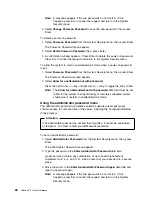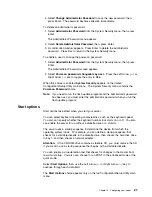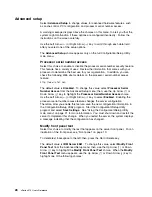
3. Set jumpers or switches on the device.
See the instructions that come with the adapter.
4. Install the adapter in the server.
See “Working with adapters” on page 68.
5. Install software programs.
See the installation instructions that come with the software.
6. Resolve configuration conflicts.
See “Resolving configuration conflicts.”
Resolving configuration conflicts
The resources used by your server consist of interrupt requests, direct memory
access (DMA), I/O ports addresses, and memory. This information is useful when
a resource configuration conflict occurs.
Conflicts in the configuration occur if:
A device is installed that requires the same resource as another device. (For
example, a conflict occurs when two adapters try to write to the same address
space.)
A device resource is changed (for example, changing jumper settings).
A device function is changed (for example, assigning
COM1
to two serial ports).
A software program is installed that requires the same resource as a hardware
device.
The steps required to resolve a configuration error are determined by the number
and variety of hardware devices and software programs that you install. If a
hardware configuration error is detected, a
configuration error
message appears
after the server completes POST and before the operating system is loaded. You
can bypass the error by pressing
Esc
while the error message is displayed.
The Configuration/Setup Utility program configures the system hardware and PCI
IRQs. The program does not consider the requirements of the operating system or
the application programs. See “Resolving software configuration conflicts” on
page 33 for additional information.
Resolving hardware configuration conflicts
Use the following information to help resolve hardware configuration conflicts:
1. Run the Configuration/Setup Utility program to view and change resources
used by the system functions and the installed options. Record the current
settings before making any changes. (See “The Configuration/Setup Utility
program” on page 20 for instructions.)
2. Determine which adapter or device is causing the conflict. (See Chapter 6,
“Solving problems” for instructions.)
3. Change adapter jumpers or switches. Some devices use jumpers and switches
to define the system resources that the devices need. If the settings are
incorrect or set to use a resource that cannot be shared, a conflict occurs and
the device will remain deactivated by the configuration program.
32
xSeries 370 User's Reference
Summary of Contents for eServer 370 xSeries
Page 1: ...User s Reference xSeries 370...
Page 2: ......
Page 3: ...IBM xSeries 370 User s Reference...
Page 32: ...16 xSeries 370 User s Reference...
Page 188: ...172 xSeries 370 User s Reference...
















































